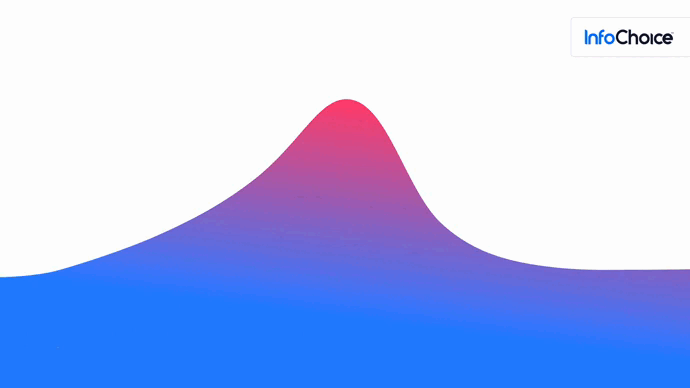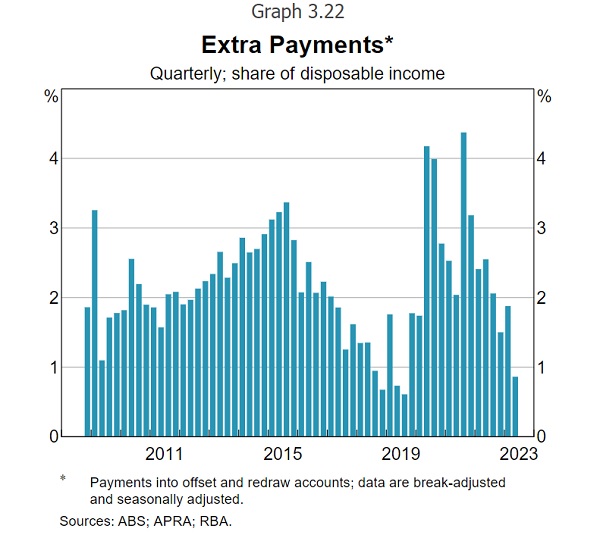
This was according to the central bank’s Statement on Monetary Policy for August 2023, which covers the impact of the series of hikes that brought the current cash rate to 4.10%.
According to the statement, banks’ funding costs have increased in response to increases in the cash rate and bank bill swap (BBSW) rates. But how did these affect the movement in deposit and lending rates?
How high deposit rates have risen
Deposit growth has slowed over the past six months than during the pandemic due to higher mortgage rates eating away at savings and disposable income.
According to the RBA’s statement, this was also in part due to the slowing credit growth which creates fewer new deposits.
Over the period, it appears depositors are favouring term deposits over at-call deposits, as the former typically provide higher returns, at a fixed rate with fewer conditions.
At-call deposits include deposits in housing loan offset accounts and non-interest-bearing deposits.
Since May 2022, the average rate on outstanding at-call deposits, which comprise around three-quarters of total deposits, has risen by 240bps. This is 160bps less than the increase in the cash rate.
The RBA said banks have increased advertised rates on “bonus savers”, where depositors need to meet certain conditions to take advantage of higher interest rates, more than on standard at-call savings accounts.
Meanwhile, the average rates on new term deposits have gone up by more than the cash rate since the start of the hiking cycle. According to the RBA, this is due to the larger movements in bank bill swap rate, which is a key benchmark used to price such products.
“Rising term deposit rates also partly reflect banks’ interest in growing term deposits given their favourable treatment in liquidity ratios, compared with at-call deposits, as they prepare for term funding facility (TFF) maturities,” the RBA's statement read.
Lending rates not keeping up with the cash rate
Interestingly, the RBA statement noted that the average rate charged on all outstanding housing and business loans has increased by only 300bps since May 2022, 100bps less than the cash rate.
Housing loans, which is around two-thirds of total credit, account for most of this difference.
Overall, lending rates have increased a little more than deposit rates on average.
Zooming to the average outstanding mortgage rate, the increase is even smaller at 275bps since May 2022.
According to the RBA, the divergence reflects the high share of fixed-rate housing loans outstanding and, to a lesser extent, the effect of discounting on variable-rate housing loans associated with strong competition between lenders.
In fact, the share of borrowers rolling off fixed-rate mortgages onto a much higher rates peaked at just 5.5% of outstanding credit in June quarter.
“It will stay high for the rest of this year, before declining in 2024. These expiries will see the average outstanding mortgage rate continue to increase as the effect of the rise in the cash rate since May 2022 flows through to a greater share of borrowers,” the RBA statement read.
Increases to mortgage rates may be picking up pace, with the average variable rate on new housing loans increasing by 29 basis points in June, more than the 25 basis point cash rate rise.
The RBA attributes this to the normalisation of the mortgage market and the withdrawal of competitive cashback offers for refinancers.
The share of extra mortgage payments is declining rapidly, with offset and redraw balances also declining in the June quarter (graph below).

The outlook for the cash rate
Economists from both CommBank and Westpac, who reacted to the RBA’s latest Statement on Monetary Policy, said it appears further cash rate increases might not be needed to meet the central bank’s inflation target.
CommBank senior economist Belinda Allen said economic data will need to print stronger than the central bank’s updated forecast for it to increase the cash rate again.
“As we note, the risks still sit with another hike, given a resilient labour market, sticky services inflation and the recovering housing market possibly boosting consumption. The hurdle though is high," she said.
Ms Allen said the base case sees the RBA to commence an easing cycle in the first quarter of 2024.
“This will see a nine-month difference between the last hike and the first cut,” she said.
“There is though a real risk that the first easing occurs later than our expectation, particularly if the labour market performs more in line with the RBA’s forecast.
“Overall, we are looking for 100bp of policy easing by end-2024 that would take the cash rate to 3.10%. We believe this is a more neutral cash rate and should see the economy begin to recover over the second half of 2024.”
Westpac chief economist Bill Evans said the RBA’s statement and its latest forecast support for the case for a hold.
“The most respectable argument for higher rates is that the forecast – which are based on flat rates – does not see the inflation rate returning to the middle of the target band,” he said.
“It appears for this Board that bringing inflation back to just 'within' the band is sufficient.”
“The issue of not returning to the middle of the band may well have to be considered at a later date, but by then I think it is likely that it will be possible to credibly forecast that return without resorting to higher rates.”
Mr Evans said a potential rate cut could be on the cards over the third quarter next year.

Photo by mirsad sarajlic on Canva.